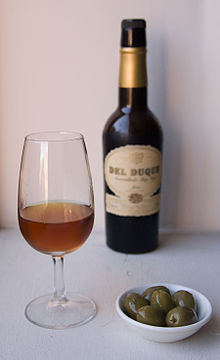| Wine region | |
 Jerez-Xérès-Sherry DOP in the province of Cádiz in the region of Andalucía | |
| Official name | D.O.P. Jerez-Xérès-Sherry[1] |
|---|---|
| Type | Denominación de Origen Protegida (DOP) |
| Year established | 1932 |
| Country | Spain |
| No. of vineyards | 6,989 hectares (17,270 acres) |
| Wine produced | 384,350 hectolitres |
| Comments | Data for 2016 / 2017 for Jerez-Xérès-Sherry and Manzanilla S.B. DOPs |

Sherry (Spanish: jerez [xeˈɾeθ]) is a fortified wine made from white grapes that are grown near the city of Jerez de la Frontera in Andalusia, Spain. Sherry is a drink produced in a variety of styles made primarily from the Palomino grape, ranging from light versions similar to white table wines, such as Manzanilla and fino, to darker and heavier versions that have been allowed to oxidise as they age in barrel, such as Amontillado and oloroso. Sweet dessert wines are also made from Pedro Ximénez or Moscatel grapes, and are sometimes blended with Palomino-based sherries.
Under the official name of Jerez-Xérès-Sherry, it is one of Spain's wine regions, a Denominación de Origen Protegida (DOP). The word sherry is an anglicisation of Xérès (Jerez). Sherry was previously known as sack, from the Spanish saca, meaning "extraction" from the solera. In Europe, "sherry" has protected designation of origin status, and under Spanish law, all wine labelled as "sherry" must legally come from the Sherry Triangle, an area in the province of Cádiz between Jerez de la Frontera, Sanlúcar de Barrameda, and El Puerto de Santa María.[2] In 1933 the Jerez denominación de origen was the first Spanish denominación to be officially recognised in this way, officially named D.O. Jerez-Xeres-Sherry and sharing the same governing council as D.O. Manzanilla Sanlúcar de Barrameda.[3]
After fermentation is complete, the base wines are fortified with grape spirit to increase their final alcohol content.[4] Wines classified as suitable for aging as fino and Manzanilla are fortified until they reach a total alcohol content of 15.5 percent by volume. As they age in a barrel, they develop a layer of flor—a yeast-like growth that helps protect the wine from excessive oxidation. Those wines that are classified to undergo aging as oloroso are fortified to reach an alcohol content of at least 17 per cent. They do not develop flor and so oxidise slightly as they age, giving them a darker colour. Because the fortification takes place after fermentation, most sherries are initially dry, with any sweetness being added later. Despite the common misconception that sherry is a sweet drink, most varieties are dry.[5][6] In contrast, port wine is fortified halfway through its fermentation, which stops the process so that not all of the sugar is turned into alcohol.
Wines from different years are aged and blended using a solera system before bottling so that bottles of sherry will not usually carry a specific vintage year and can contain a small proportion of very old wine. Sherry is regarded by some wine writers[7] as "underappreciated"[8] and a "neglected wine treasure".[9]
- ^ "Denominación de Origen Protegida "Jerez-Xérès-Sherry"". mapa.gob.es. Retrieved 10 January 2020.
- ^ "Quality Control – Vintage Direct". Archived from the original on 10 September 2013. Retrieved 10 January 2015.
- ^ "Foods and Wines from Spain. Everything you should know about Spanish food, Spanish wine and gastronomy from Spain". foodswinesfromspain.com. Archived from the original on 29 June 2009.
- ^ "Classification and Fortification". sherry.org. Regulatory Council of Sherry Wines. Archived from the original on 10 January 2015. Retrieved 10 January 2015.
- ^ Lyons, Will (12 August 2015). "The Aperitif for Every Season". The Wall Street Journal. Archived from the original on 13 August 2015. Retrieved 26 June 2024.
- ^ Dao, Dan Q (29 June 2023). "A Guide to Sherry Varieties: Everything You Need to Know About Spain's Famed Fortified Wine". Serious Eats. Archived from the original on 24 February 2024. Retrieved 26 June 2024.
- ^ Eric Asimov, "For Overlooked Sherries, Some Respect" Archived 1 July 2017 at the Wayback Machine, The New York Times, 9 July 2008.
- ^ Karen MacNeil (2001), The Wine Bible (Workman Publishing, ISBN 978-1-56305-434-1), 537: "the world's most misunderstood and underappreciated wine".
- ^ Jancis Robinson, Sherry Archived 14 May 2011 at the Wayback Machine (5 September 2008): "The world's most neglected wine treasure".